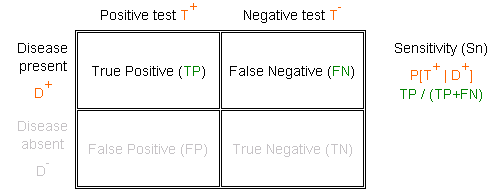
StATS: What is sensitivity?
The sensitivity of a test is the probability that the test is positive when given to a group of patients with the disease. Sensitivity is sometimes abbreviated Sn.
The formula for sensitivity is
Sn = TP / (TP + FN)
where TP and FN are the number of true positive and false negative results, respectively. You can think of sensitivity as 1- the false negative rate. Notice that the denominator for sensitivity is the number of patients who have the disease. Using conditional probabilities, we can also define sensitivity as
Sn = P [ Test is positive | Patient has the disease ]
The following table summarizes these calculations.

A large sensitivity means that a negative test can rule out the disease. David Sackett coined the acronym "SnNOut" to help us remember this.
Here is an example of a sensitivity calculation.
This page was written by Steve Simon while working at Children's Mercy Hospital. Although I do not hold the copyright for this material, I am reproducing it here as a service, as it is no longer available on the Children's Mercy Hospital website. Need more information? I have a page with general help resources. You can also browse for pages similar to this one at Category: Definitions, Category: Diagnostic testing.